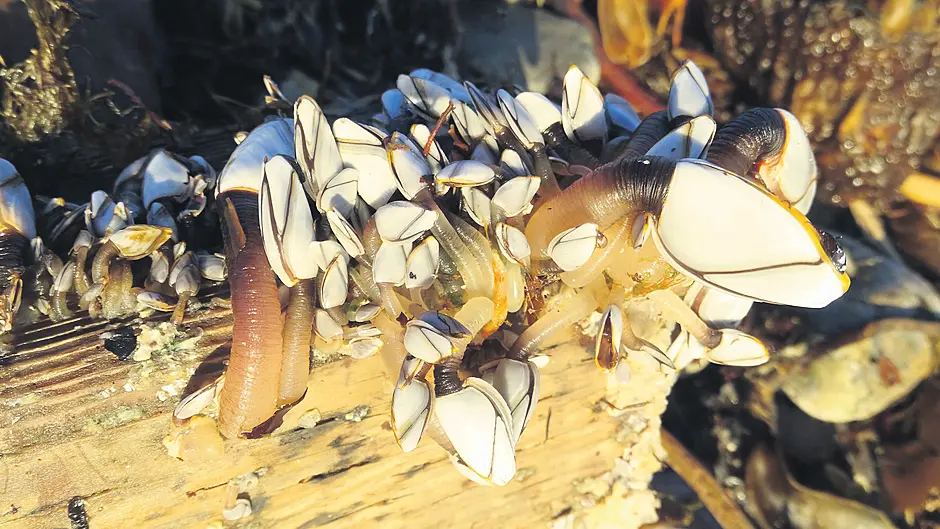By ANN HAIGH
UP until a few years ago I hadn’t heard of gooseneck barnacles (Lepas anatifera) but recently we’ve been seeing so many of these crustaceans on our local beaches that they are hard to miss.
We’ve found them on beach litter such as shoes, bottles, fish-boxes, crates, buoys and polystyrene. It seems they will attach to almost anything that floats on the sea. Prior to the age of plastic, they would have only been found on ships’ hulls, ropes, driftwood, seaweed and sometimes sea turtles. However, more recently ocean litter is providing a lot more for them to attach to.
Gooseneck barnacles are curious looking creatures. They have a white shell up to 5cm long, made up of five smooth plates and they attach to solid surfaces by a fleshy stalk. The stalk can be up to 80cm long, but is usually closer to 4-10 cm, it reminds me of cola bottle gummy sweets. This may seem a strange association but the stalk is soft, yet tough, and is semi-translucent with brown coloration. The gooseneck barnacle is a pelagic (open ocean) species, most often found in tropical and subtropical waters. They feed by extending feather-like structures from their shell which filter the sea water and are efficient at trapping prey such as plankton.
How they hitch a ride
So how do they move from the open ocean to our beaches? They are hermaphrodites that reproduce in warmer waters by internal fertilisation. Free-swimming larvae are released into the ocean and these larvae seek out a surface to attach to. Due to our planet now having so much ocean litter, this is frequently where they latch. Westerly gales and the current of the North Atlantic Drift then bring ocean debris with the barnacles on to our shores. Once they wash up, they are initially alive and their stalks can be seen retracting and extending.
They do not survive out of water for long periods, so unless they are transported back to the open ocean, they unfortunately die. When they are still alive it’s always a dilemma to know what to do. It is counter-intuitive to throw litter, even with barnacles on, back into the sea. The chances are they would only wash up again, so sadly when we’re out collecting litter if these barnacles are on something like a plastic bottle, I don’t put them back in the sea.
Ocean litter
Ocean litter is an ongoing and major environmental issue. According to the IUCN (International Union for Conservation of Nature) an estimated 10m tonnes of litter enter the world’s oceans each year and plastic makes up 80% of this. Consequences include wildlife entrapment and entanglement, damage to habitats, transport of non-native or invasive species from one area to another (hitching lifts) and ingestion by marine wildlife. Many of us have seen the horrifying post-mortem photographs of whales, with their opened stomachs shown to be packed full of plastic. Even a study on gooseneck barnacles found that 33.5% of them had ingested plastic in their digestive system. The effects of eating plastic for marine creatures may include blockage of the digestive system, reduced feeding, altered hormone levels and reduced ability to reproduce. What we see on our coastline is only part of the problem. It’s estimated that 70% of marine litter is on the seabed, 15% is floating in the water column and 15% is what we can find and pick up from our beaches.
Pollution solutions
If we don’t act there will be more plastic in the ocean than fish by 2050. This is a horrifying prospect. Even though, as members of the public, we only have access to a relatively small percentage of the total ocean litter, by working together we can make a huge difference to the damaging plastic and litter on our coastlines. It’s been studied that for the first five years, 77% of land originated litter stays by the coast line. So, if you’re looking for something good to do in 2023, visiting your local beach to remove litter and prevent deeper ocean pollution is up there on the good deed list. Various groups such as Clean Coasts (An Taisce), Flossie and the Beach Cleaners and the local Oceans Plastics Project run many initiatives throughout the year. An easy one to join is the Two Minute Beach Clean by Clean Coasts. You can look up these initiatives online, but if you don’t want to make things too complicated, just removing, recycling or safely disposing of five pieces of litter from the beach each time you go will help. If more of us did this it would make a significant difference. If you don’t visit the coast often, you could also help by making sure your local river is litter free. It is important to manage litter by our waterways before it can flow out the sea.
There are various innovative technologies and processes in development and early-stage use that aim to reduce and remove plastic pollution from the ocean. Additionally, tighter Irish government regulations on single use plastic and producers of plastic packaging and fishing gear are being phased in. By February 2024 a plastic bottle and aluminum/steel can deposit return scheme will be in place, details may be found at www.re-turn.ie.
It is fascinating to find these mysterious hitch-hiking gooseneck barnacles on our shores attached to ocean litter. We can only wonder at how far and from where they have traveled. However, the moral of the story is that the litter they are hitchhiking on is a very serious issue and a sign that things need to change.
• Ann Haigh MVB MSc MRCVS is a Skibbereen resident, a mum-of-two and a veterinarian with a masters in wildlife health and conservation and she is passionate about biodiversity and nature








